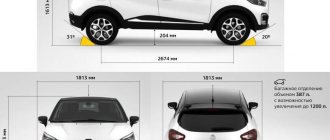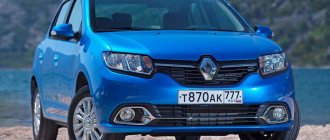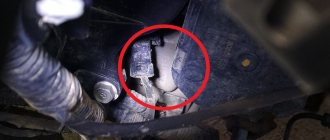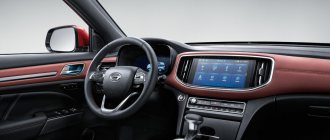What class does it belong to?
The Kia Rio class occupies a middle position between “C” and “B”. The length of the car is either 4.3 meters (sedan) or 4 m (hatchback). The height of both types is the same, it slightly exceeds 1.4 m. An identical situation arises in relation to the width - 1.7 meters. In terms of length, it would seem that the car fits perfectly into the C-class. On the other hand, we also cannot forget about optional characteristics. The base model is equipped with a 1.4-liter engine with a maximum power of 107 horsepower. Looking at these parameters, it is difficult to classify the Rio as a C-class, since there is an obvious “B” here. For comparison, here are a few examples of vehicles of this type. These include Fiat Punto, Opel Corsa, Ford Fiesta, Hyundai Accent, Volkswagen Polo and several others. It is noticeable from the list: most of the representatives are hatchbacks, but there are also several compact sedans.
Let's consider the question “What class of Kia Rio” in more detail. One version of the car can still be classified as “C”. The sedan, equipped with a 1.6-liter engine producing 123 horsepower, belongs to this class. The car has a length of 4.3 meters and corresponding technical characteristics. 107-horsepower sedans and hatchbacks are more suitable for “B”. To make sure that the C-Class is demonstrated by more powerful examples, a few examples will help. Audi A3, Volkswagen Golf, Ford Focus, BMW 3, Toyota Corolla are representatives of this type of car. Obviously, Rio is hardly appropriate to be considered on an equal footing with them. It is more logical to classify it as “B”.
Technical specifications Kia X-Line
The characteristics of the Kia Rio X Line are presented in two types of engine and gearbox. For lovers of leisurely driving, there is a modification of the car with a 1.4 liter engine and automatic or manual transmission.
For those who like more power, you can purchase a modification with a 1.6 liter engine and a transmission of your choice. The younger version of the engine has a power of one hundred horsepower, and the older version can boast as many as one hundred and twenty-three horses.
Equipping the car with a more powerful engine will allow it to accelerate to 183 kilometers per hour. Kia Rio X with a junior engine will be able to reach a top speed of 176 kilometers per hour. The configurator is designed to help you choose the most suitable option, which can be found on the official Kia website.
Despite the fact that the car is positioned as an SUV, there is no all-wheel drive. All trim levels use exclusively front-wheel drive.
Fuel consumption is as follows:
- City. In the urban cycle, a car with a 1.4-liter engine consumes 7.4 liters when using a manual transmission or 8.6 liters with an automatic transmission. The older model, equipped with a 1.6-liter engine, consumes 8.7 and 8.9 liters with manual and automatic transmissions, respectively.
- Out of town. When driving outside the city, the 1.4 liter engine consumes 5 liters per hundred kilometers. The more powerful 1.6 liter engine consumes 5.4 and 5.6 liters for manual and automatic, respectively.
- Mixed mode. Driving in this mode consumes 5.9 and 6.6 liters on manual and automatic transmissions, respectively, for the younger engine. The powerful engine consumes 6.6 and 6.8 liters depending on the installed transmission.
The weight of the Kia X-Line with a 1.4-liter engine and manual gearbox is 1155 kilograms. Installing an automatic transmission increases the vehicle's curb weight to 1187 kilos.
The model with a more powerful engine weighs 1175 kilograms for a manual transmission and 1203 kilograms for an automatic transmission.
Auto parts for the Kia X-Line vehicle can be purchased from official Kia dealers in Russia.
Starting from 2021, this car model is produced at the St. Petersburg HMMR plant, so there should be no questions about whose assembly when buying a car in the Russian Federation. A more detailed description of the plant for the production of these cars can be found on the website: https://www.hyundai.ru/XMMP.
Currently, the Kia X-Line has gained wide popularity among lovers of inexpensive and practical cars. The huge variety of car racks for Kia Xline on the market brought special joy to car enthusiasts.
Installing a car trunk solves almost all the problems associated with the relatively small original storage of a vehicle.
X Line engines
As mentioned above, X-line engines can be of two types:
- 4 liter with one hundred horsepower and six thousand revolutions.
- 6 liter with one hundred twenty-three horses and a power of six thousand three hundred revolutions.
The width of the vehicle does not depend on the type of engine used. Engines must be refueled with gasoline of at least grade 92. Both engines are built on the basis of four cylinders and sixteen valves.
The emission of harmful exhaust gases complies with the Euro 5 standard. As mentioned earlier, there is no all-wheel drive option for the X-Line trim level.
Dimensions of the car body and interior
The car body dimensions are:
- length – 4,240 millimeters;
- width – 1,750 millimeters;
- height - 1,510 millimeters;
- wheelbase - 2,600 millimeters.
The minimum turning radius of the car is 5.2 meters, and the ground clearance is 17 cm.
The interior dimensions of the Kia X-Line are:
- Front legroom – 1070 mm;
- Rear legroom – 870 mm;
- ceiling height above the driver – 991 mm;
- The ceiling height above the rear sofa is 966 millimeters.
Types of transmissions
The vehicle is equipped with a manual or automatic gearbox. Both transmissions have six gears. The clutch of the manual hatchback is of the dry single-disc type. The automatic transmission uses a hydraulic clutch for the clutch.
The volume of lubricant in a manual transmission is 1.6 liters, and in an automatic transmission the amount of oil is 6.7 liters.
Equipment Comfort
The Kia Rio X Line 2021 car in the Comfort configuration offers the buyer:
- Air conditioner.
- Heated glass.
- Electric windows.
- Full set of security systems.
- Heated steering wheel.
- Adjusting the steering wheel for reach.
- Leather trim on the gear selector lever.
The volume of the fuel tank does not depend on the modification and is fifty liters.
Luxury equipment
The technical characteristics of the luxury package include only the older 1.6 liter engine.
In addition, additional equipment includes:
- climate control;
- fog lights;
- LED lights.
In this configuration of the Rio X line, the volume of the fuel tank does not change.
Premium package
This is the most expensive option for equipping a car. Here the driver is presented with:
- large sixteen-inch wheels;
- led lights;
- full leather interior;
- starting the engine with a button;
- seven-inch navigation screen;
- heated windshield and rear seats;
- Rear View Camera.
The car in the premium configuration comes exclusively with the older 123 horsepower version of the engine and a six-speed automatic gearbox.
The cost of the most expensive x-line package starts from 1,025,000 rubles.
Kia Rio class - Car class of Kia Rio and Hyundai Solaris
Despite the fact that the design of the Kia Rio is more reminiscent of a sporty style, which is manifested in the elongated shape of the headlights, radiator grille, chrome strip and other elements, this car comes on sale at an affordable price from 479 thousand rubles. Kia Rio is positioned as a budget B-class vehicle that does not require high maintenance costs. Today there are nine possible body colors on sale and three available options with different wheel rims. In order not to increase the cost of the car after the update, the manufacturer decided to abandon the new line of engines and used the same efficient and proven power units in the design.
The interior also did not focus on excesses, but it looks attractive and pleases with stylish and memorable solutions despite the class of the Kia Rio car.
The lighting is well designed, and the arrangement of the elements only emphasizes the author’s idea.
Design
In terms of design, the Rio's FB-code suspensions remain unchanged, with MacPherson struts still at the front and a torsion beam at the rear. But as a result of the change of generations, the location of the parts of the steering mechanism has changed, receiving an electric steering instead of a power steering, and the gearbox support has also changed. The track has widened, castor (the angle of longitudinal inclination of the front wheels' turning axis) has increased from 4.1° to 4.6°, and the camber is now not positive, but negative. The rear beam is borrowed from the Hyundai Creta and Elantra, and the new Mando shock absorbers, which are longer than the old ones, are mounted behind the rear axle at an angle of 8.4 degrees, rather than in front of it at an angle of 25 degrees. The vacuum brake booster has grown in diameter from 9 inches to 10 and, as a result, the force it develops has increased. The off-road Rio differs from a regular four-door in its springs and shock absorbers (the compression stroke is 1 cm longer) and the corresponding power steering settings.
Suspension, brakes and wheels KIA Rio X-Line 2019-2020
The architecture of the suspension remains unchanged. The front has independent springs with McPherson struts and anti-roll bars. At the rear there is a torsion beam with springs. The main difference from the sedan is different springs, shock absorbers and corresponding steering settings. In February 2021, the company announced that all versions of the cross-hatchback will receive increased ground clearance to 190 mm, and for the Premium version it is even higher - 195 mm (at the start of production, the ground clearance for all versions was 170 mm).
The suspension is well suited for bad roads - it is energy-intensive and takes impacts well. On the move, the Rio sedan, due to stiffer springs and shock absorbers, turned out to be more rigid than the platform Solaris. But for the Rio X, the suspension has received comfortable settings, and with 15-inch wheels and high-profile tires, the car feels even softer.
The steering is now equipped with electric power steering. The steering wheel is light - it's convenient in the city. In other driving modes, there may not be enough reactive force on the steering wheel. On poor surfaces, vibrations are transmitted to the steering wheel.
Front disc brakes on all versions. There are options at the rear: available versions have drum brakes, and more expensive versions have disc brakes. ABS is available as standard.
For simple versions, 15-inch steel wheels with decorative caps and 185/65R15 tires are provided. Starting with the Prestige trim level, 15-inch alloy wheels are installed. The most expensive Premium version has 16-inch alloy wheels with 195/55R16 tires. The basic equipment includes a tire pressure monitoring system.
Luggage compartment
The trunk of the restyled sedan has undergone virtually no changes, and its volume remains the same (480 liters). Although the Rio sedan belongs to the B-class, the depth of its cargo compartment is comparable to the trunk of a C-segment passenger car, but the opening itself is quite narrow, and loading and unloading here is not as convenient as in a liftback or hatchback.
The trunk here does not have any special frills, but in the top it is still endowed with a remote control function, in which case the lock is activated, then the lid must be lifted manually.
Like many sedans, the Rio's trunk lid has fairly large and massive hinges, and they somewhat limit usable space.
Dimensions of Kia Rio of different generations
The first Kia Rio sedans had a length of 4215, a width of 1675, and a height of 1440 millimeters. The wheelbase is 2410. The dimensions of the first generation station wagons are the same as those of the sedan. The distance between the wheel axles is also 2410.
The declared car class is B.
Kia Rio 2000 1st generation
Kia Rio 2 sedans received a body extended to 4250 mm. The width increased to 1695 and the height to 1470 millimeters. The wheelbase size increased to 2500. The length of the Kia Rio 2 hatchback was 4025. The width and height were the same as the sedan - 1695 and 1470, respectively, the distance between the front and rear axles was 2500 millimeters.
Kia Rio 2005 2nd generation
The Kia Rio 3 sedan lengthened to 4377 and widened to 1700, the height remained at the level of the 2nd generation - 1470 millimeters. The wheelbase size has increased to 2570. The length of hatchbacks , compared to the previous generation, has increased to 4125. Width, height - 1700, 1470. The wheelbase also corresponds to a similar parameter for a sedan.
Kia Rio 2011 3rd generation
The length of the new Kia Rio 4 sedan reached 4400, the width increased to 1740, the height remained at 1470. The base size was 2600.
Kia Rio 2016
Notes[ | ]
- Euro NCAP test results (2005) (English)
- Top secret: for Russia ─ with love Archived copy dated June 4, 2011 on the Wayback Machine // kia.ru
- Kia lifts the veil of secrecy over a new model for the Russian market Archived copy dated June 4, 2011 on the Wayback Machine // kia.ru
- New Kia Rio: key characteristics (inaccessible link) // kia.ru
- Production of the new Kia Rio started in August 2011. Archived copy dated July 3, 2011 on the Wayback Machine // kia.ru
- Euro NCAP test results (2011) (English)
- +KiaMotorsRussia.
Serial production of the new generation KIA Rio began at the plant in St. Petersburg (Russian) (inaccessible link). www.kia.ru. Date accessed: April 12, 2021. Archived April 13, 2019. - +KiaMotorsRussia.
Sales of the new generation KIA Rio have started - the most popular car in Russia (Russian) (inaccessible link). www.kia.ru. Date accessed: April 12, 2021. Archived April 13, 2021. - +KiaMotorsRussia.
KIA presents a new model for the Russian market – cross-hatchback Rio X-Line (Russian) (inaccessible link). www.kia.ru. Date accessed: April 13, 2021. Archived April 13, 2019. - +KiaMotorsRussia.
Sales of the new cross-hatchback KIA Rio X-Line (Russian) have started (inaccessible link). www.kia.ru. Date accessed: April 13, 2021. Archived April 13, 2021. - +KiaMotorsRussia.
KIA Rio X-Line rises to new heights (Russian) (inaccessible link). www.kia.ru. Date accessed: April 13, 2021. Archived April 13, 2021. - Updated Kia Rio sedan for Russia: configurations and prices (Russian) (September 14, 2020). Date accessed: October 9, 2021.
- KIA Rio fuel consumption (unspecified)
. Date accessed: August 3, 2021.
Multimedia
Most configurations include a simple radio with a radio, 4 speakers and AUX/USB connectors for connecting gadgets. A full-fledged multimedia complex with a seven-inch color touchscreen, navigation, 6 speakers, Bluetooth and rear video view is available only in the most expensive version. Navigation works surprisingly well, but given the media system's compatibility with Apple CarPlay and Android Auto, it's not particularly necessary. The sound quality and display graphics are at an acceptable level.
Kia Rio X-Line Technical specifications
The X-Line's engines and transmissions are sedan-like. The engine range includes unpretentious petrol fours of 1.4 and 1.6 liters, developing 100 (or, more precisely, 99.7 hp) and 123 hp. respectively. Both are comfortable with 92-octane gasoline, meet the Euro-5 eco-standard and are combined with a 6-speed manual transmission or an automatic transmission with the same number of steps. The top-end 1.6-liter G4FG unit of the Gamma series (left) is produced on territory of the People's Republic of China. It is distinguished from its predecessor G4FC by different camshafts, pistons, a variable-length intake tract and a second exhaust camshaft. With 123 hp remaining. torque decreased from 155 Nm to 150.7 Nm, and crankshaft speed increased from 4200 rpm to 4850 rpm. As for the base 1.4-liter G4LC engine (on the right) of the Kappa family, it appeared in connection with the change of Rio generations and became completely new for the model. It also has a variable length intake manifold, 2 phase shifters and a timing chain drive. Power level - 99.7 hp. versus 107 hp the old G4FA engine, and the peak torque is 132.4 Nm versus the previous 135.4 Nm, but at 4 thousand rpm instead of 5 thousand. There is no decorative cover on the engine, no sound insulation on the hood and no gas stop. Six-speed automatic transmission The X-Line received an improved torque converter - with 4 clutch discs, rather than just one, and with redirected oil flows. It blocks faster, more often and harder. The country of origin is South Korea, and the country of origin of the manual transmission is the Czech Republic.
Second generation[ | ]
| Kia Rio JB | |
| Total information | |
| Manufacturer | Kia Motors |
| Years of production | 2005—2011 |
| Assembly | Sohari Plant, Gwangmyeong, South Korea Yancheng, China Quito, Ecuador (AYMESA) Jakarta, Indonesia Bicutan, Parañaque City, Philippines Izhevsk, Russia |
| Other designations | Kia New Pride (in South Korea) Kia Rio5 (hatchback in North America) Kia New Pride Sedan (in Indonesia) Kia New Pride (hatchback in Indonesia) |
| Design | |
| Body type | 5-door hatchback (5-seater) 4-door sedan (5-seater) |
| Platform | Hyundai Accent MC |
| Engine | |
| petrol: 1.4−1.6 liters (71−82 kW) diesel: 1.5 liters (81 kW) | |
| Transmission | |
| 5-speed Manual transmission 4-speed Automatic transmission | |
| Weight and dimensions characteristics | |
| Length | Hatchback: 3990 mm 2005−2009 sedan: 4240 mm 2009−2011 sedan: 4250 mm |
| Width | 1695 mm |
| Height | 1470 mm |
| Wheelbase | 2500 mm |
| Rear track | 1460 mm |
| Front track | 1470 mm |
| Weight | 1154−1266 kg |
| Dynamic characteristics | |
| Acceleration to 100 km/h | 12.3−10.2 s |
| Maximum speed | 166−188 km/h |
| On the market | |
| Related | Hyundai Accent MC |
| Other information | |
| Designer | Peter Schreyer (restyling) |
| |
| Media files on Wikimedia Commons | |
In the fourth quarter of 2005, the second generation entered the market.
In 2010, Kia Motors, in collaboration with German designer Peter Schreyer, updated the model, changing the grille, steering wheel, front and rear bumpers, adding a spoiler to the luxury package, and also adding several new colors. However, neither the wheelbase of sedans and hatchbacks nor the interior dimensions have changed. Since 2010, it has been assembled in Russia in Kaliningrad at the Avtotor plant.
Security[ | ]
At the NCAP crash test, Rio received:
| Euro NCAP[1] | |||
| Ratings | Passenger | 29 | |
| Child | 34 | ||
| A pedestrian | 13 | ||
| Model tested: Kia Rio (2005) | |||
Engines[ | ]
One diesel and two gasoline engines were offered. The gearbox is a five-speed manual. Both the 1.4-liter and 1.6-liter petrol engines are available with a four-speed automatic transmission. Only the version with a 1.4 liter engine and a choice of manual or automatic transmission was officially supplied to Russia.
| Model | Cylinders / Valves | working volume | Power | Torque |
| 1.4 L G4EE | in a row 4/16 | 1399 cm³ | 71 kW (97 hp) at 6000 rpm | 125 Nm at 4700/min |
| 1.6 L G4ED | in a row 4/16 | 1599 cm³ | 82 kW (112 hp) at 6000 rpm | 146 Nm at 4500/min |
| 1.5 L CRDi D4FA | in a row 4/16 | 1493 cm³ | 81 kW (110 hp) at 4000 rpm | 235 Nm at 1900/min |
Used materials
Today you can create a high-quality interior appearance of a car without even using expensive materials.
The designers tried to make sure that the budget car remained so after all the work was completed. The inexpensive plastic from which the front panel is made is easy to clean and has sufficient strength. Compared to the Volkswagen Polo, the Kia Rio has higher quality materials.
How to check if the body is galvanized?
Checking the body of a Kia Rio is extremely simple. To do this, you need to monitor the chip on any part of the body. If over time the bare metal remains clean and no signs of the beginning of the corrosion process appear, then galvanization of the body is present.
As a rule, on Kia Rio 3 and earlier models, the body was galvanized. Engineers of the Korean manufacturer claim that all cars undergo mandatory processing of all body elements, with the exception of the roof.
These words are confirmed by many owners of this car model. Driver reviews indicate that Rio cars of the third and earlier generations, when chipped paintwork appears, do not show signs of oxidation and corrosion.
However, in a thread on one of the well-known auto forums located at the link https://www.drive2.ru/l/4657446/ it is clearly visible that the third generation Rio car is covered with rust.
This can probably be considered a defect, since even in the comments on this topic there are more than a dozen owners of similar cars with more successful bodies.
More modern car models such as Rio 2021 and Kia Rio x Line do not always have sufficient processing.
Thus, many owners of new Rio models complain that traces of corrosion appear on the chips that appear within several months, which indicates that the cases are not galvanized or are done poorly.
The occurrence of corrosion spots significantly damages the exterior of the Kia Rio and impairs the reliability of the vehicle body structure.
Types of galvanization of the Kia Rio body
Since 2011, all Rio vehicles have undergone a galvanizing process. This processing of body elements is partial.
Galvanization is carried out with the following parameters:
- Type of processing – partial. A partial type of anti-corrosion treatment allows you to protect key connections and the most vulnerable parts of the body from corrosion.
- The type of galvanizing used is zinc metal. This type of processing is one of the lowest quality. With zinc-metal galvanization, the vehicle receives a weak degree of protection against corrosion and poor resistance to mechanical damage to the zinc layer.
- The processing method is the application of zinc particles during the metal rolling process, followed by the spraying of zinc oxides. This approach makes it possible to integrate zinc particles into steel and significantly increase the service life of the anti-corrosion coating.
The destruction of the zinc layer in places where the paintwork is damaged occurs at a rate of one to six micrometers per year. More active destruction of the protective layer occurs at elevated temperatures.
Therefore, the cyclometal anti-corrosion treatment mechanism provides up to nine years of rust resistance.
Supply of metal for Kia Rio bodies
According to the technological process, the car of the Korean manufacturer Kia uses metal from Hyundai. Metal sheets are directly supplied from Korea, where its primary processing and galvanization are carried out.
The process of anti-corrosion treatment of Rio body elements includes:
- applying factory zinc coating to a sheet of metal;
- treatment with zinc-containing oxides at the painting stage;
- immersion of the finished body in a cataphoresis bath.
Recently it became known that new car bodies began to be made of metal produced by the Severstal company. Kia claims that there is no reason to panic, because the Russian plant has the same technical requirements as the plant in Korea.
Nevertheless, after the release of cars with metal produced by Severstal, information began to appear more and more often about the detection of corrosion in relatively new Kia Rio cars.
Small middle class models
KIA Ceed has long remained the most advanced car in the small middle class.
The exterior and interior of this Kia model are equally attractive, meeting all the requirements of city life. Everything inside is designed for driver comfort, the front panel is easy to use, and the high-quality interior materials are soft to the touch. The radiator grille, a lot of chrome, LED headlights and LED running lights allow you to stand out on the road. Of the engines offered, the most popular is the 140 hp unit. The safety of KIA Sid passengers is ensured by innovative systems.
The low roofline and streamlined body shape create the sporty character of the KIA ProCeed.
At the same time, the car looks quite elegant. The sound of the Pro Sid engine, for which the exhaust pipes are responsible, received high marks. The LED rear lights create a line across the entire width of the estate. Along with them, the honeycomb-shaped radiator grille and running lights resembling ice cubes have a stylish look. The engine power in the best configuration is 170 hp, and steering wheel paddle shifters provide easy switching. Cruise control and safety systems guarantee a comfortable and safe ride.
New body KIA Rio X-Line 2019-2020
Like the sedan, the Rio X-line hatchback boasts a new body, which was developed by KIA’s Californian and German design centers. The new, swift silhouette was achieved due to a longer hood, a short front overhang and A-pillars shifted towards the driver. The signature radiator grille is actually decorative, and all the air is taken in through the front bumper grille. The designers' work was awarded the Red Dot Award 2017 and the iF Design Award 2021.
The hatchback has a higher roofline. The rear door opening has become higher, and entry into the rear row of seats is more comfortable. Together with thin A-pillars and a large glass area, the Rio X will delight you with good visibility. Although, the exterior mirrors could be larger.
In the new body, the share of high-strength steels reached 50% (13% more than its predecessor). The design also uses hot-formed steel to strengthen the front end of the body.
The main difference between the Russian version of the Rio hatchback and the European one is different front and rear bumpers with silver lining, an unpainted plastic skirt along the bottom of the body, roof rails, and dual exhaust pipes. All body elements of the Russian version are aimed at creating a “crossover” image.
The headlights are halogen, projective in more expensive versions. Top trim levels feature LED running lights in the front bumper and LED taillights.
Body length 4240 mm, width 1750 mm, height 1510 mm. The wheelbase, like a sedan, is 2600 mm. Curb weight, depending on the configuration, is 1155 - 1269 kg.
There are 9 color options available for the body.










